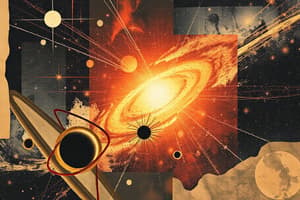Podcast
Questions and Answers
Which of the following processes is responsible for the formation of the heaviest elements in the universe?
Which of the following processes is responsible for the formation of the heaviest elements in the universe?
- Proton-Proton Chain Reaction
- Stellar Nucleosynthesis
- Big Bang Nucleosynthesis
- Supernova Nucleosynthesis (correct)
What is the approximate percentage of helium in the universe according to the text?
What is the approximate percentage of helium in the universe according to the text?
- 75%
- 24% (correct)
- 1%
- 50%
Which of the following is not a piece of evidence supporting the Big Bang theory?
Which of the following is not a piece of evidence supporting the Big Bang theory?
- Abundance of light elements
- Abundance of heavy elements (correct)
- Occurrence of redshift
- Background radiation
What is the primary mechanism responsible for the production of heavier elements (Carbon-Iron) in stars?
What is the primary mechanism responsible for the production of heavier elements (Carbon-Iron) in stars?
Who is credited with the creation of the periodic table in its modern form?
Who is credited with the creation of the periodic table in its modern form?
What crucial contribution did Henry Moseley make to the periodic table?
What crucial contribution did Henry Moseley make to the periodic table?
How are transuranic elements typically produced?
How are transuranic elements typically produced?
What determines the polarity of a molecule according to the text?
What determines the polarity of a molecule according to the text?
Which element is commonly used in nuclear reactors and weapons?
Which element is commonly used in nuclear reactors and weapons?
What is the primary role of lipids in living organisms?
What is the primary role of lipids in living organisms?
Study Notes
The Big Bang Theory
- The universe began with a Big Bang, an extremely hot and dense state that expanded rapidly
- Evidence supporting the Big Bang Theory includes: • Redshift occurrence • Background radiation • Abundance of light elements (Hydrogen-75%, Helium-24%, other light elements-1%)
Origin of Elements
- Big Bang (Primordial Nucleosynthesis): formed light elements (Hydrogen, Deuterium, Tritium, Helium, Alpha particle, Lithium, Beryllium)
- Stellar Nucleosynthesis: formed heavy elements (Carbon-Iron) through proton-proton chain reaction, Carbon-Nitrogen-Oxygen cycle, Triple Alpha Process, and alpha ladder process
- Supernova Nucleosynthesis: formed heavier elements during explosive death of massive stars (supernovae) through s-process and r-process
Model of an Atom
- Electrons: negatively charged particles
- Protons: positively charged particles
- Neutrons: neutral particles with no electric charge
Periodic Table of Elements
- Dmitri Mendeleev credited with creating the modern periodic table (1869) organized by increasing atomic mass and grouped by chemical properties
- Henry Moseley determined atomic numbers of elements (1913) and rearranged the periodic table based on atomic number, resolving inconsistencies
Transuranic Elements
- Elements with atomic numbers greater than uranium (92) on the periodic table
- Synthetic, created artificially through nuclear reactions in laboratories
- Examples: plutonium (94), neptunium (93), americium (95)
Polarity of Molecules
- Refers to the distribution of electric charge within the molecule, resulting in partial positive and negative charges
- Determined by: • Electronegativity: measures an atom's ability to attract electrons • Geometrical shape of the molecule (via VSEPR theory)
- Predicting molecular geometry: Lewis Dot Diagram, counting valence electrons, determining the central atom, and drawing single bonds
Biological Macromolecules
- Carbohydrates: • Energy source for organisms • Elements: C, H, and O • Food sources: white rice, white bread, fruits, potatoes, cakes, and sugary beverages
- Lipids: • Energy storage molecules • Structural role: form cell membranes, providing a barrier between the cell and its environment • Elements: C, H, and O • Food sources: fatty fishes, etc.
Studying That Suits You
Use AI to generate personalized quizzes and flashcards to suit your learning preferences.
Description
Test your knowledge on the Big Bang Theory, the cosmic expansion that marked the origin of the universe. Explore the evidence supporting this theory and learn about the origin of elements in the universe.




